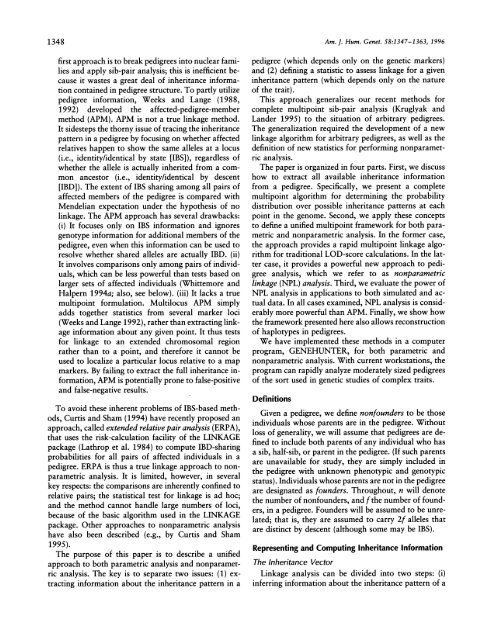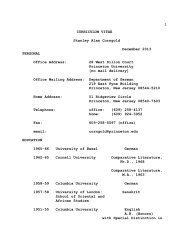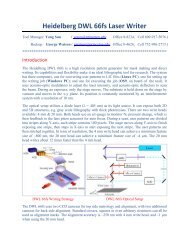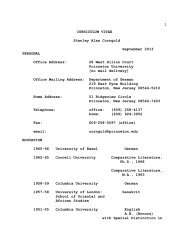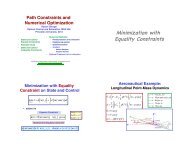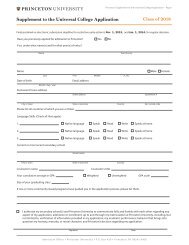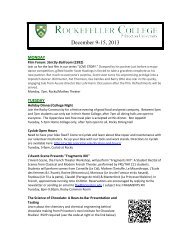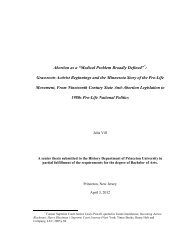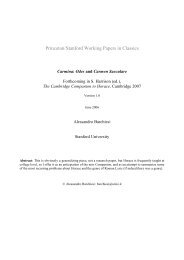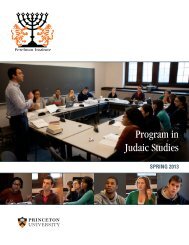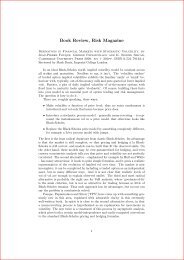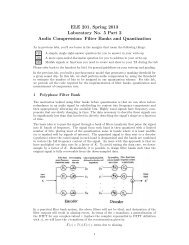Parametric and Nonparametric Linkage Analysis - Princeton University
Parametric and Nonparametric Linkage Analysis - Princeton University
Parametric and Nonparametric Linkage Analysis - Princeton University
Create successful ePaper yourself
Turn your PDF publications into a flip-book with our unique Google optimized e-Paper software.
1348<br />
first approach is to break pedigrees into nuclear families<br />
<strong>and</strong> apply sib-pair analysis; this is inefficient because<br />
it wastes a great deal of inheritance information<br />
contained in pedigree structure. To partly utilize<br />
pedigree information, Weeks <strong>and</strong> Lange (1988,<br />
1992) developed the affected-pedigree-member<br />
method (APM). APM is not a true linkage method.<br />
It sidesteps the thorny issue of tracing the inheritance<br />
pattern in a pedigree by focusing on whether affected<br />
relatives happen to show the same alleles at a locus<br />
(i.e., identity/identical by state [IBS]), regardless of<br />
whether the allele is actually inherited from a common<br />
ancestor (i.e., identity/identical by descent<br />
[IBD]). The extent of IBS sharing among all pairs of<br />
affected members of the pedigree is compared with<br />
Mendelian expectation under the hypothesis of no<br />
linkage. The APM approach has several drawbacks:<br />
(i) It focuses only on IBS information <strong>and</strong> ignores<br />
genotype information for additional members of the<br />
pedigree, even when this information can be used to<br />
resolve whether shared alleles are actually IBD. (ii)<br />
It involves comparisons only among pairs of individuals,<br />
which can be less powerful than tests based on<br />
larger sets of affected individuals (Whittemore <strong>and</strong><br />
Halpern 1994a; also, see below). (iii) It lacks a true<br />
multipoint formulation. Multilocus APM simply<br />
adds together statistics from several marker loci<br />
(Weeks <strong>and</strong> Lange 1992), rather than extracting linkage<br />
information about any given point. It thus tests<br />
for linkage to an extended chromosomal region<br />
rather than to a point, <strong>and</strong> therefore it cannot be<br />
used to localize a particular locus relative to a map<br />
markers. By failing to extract the full inheritance information,<br />
APM is potentially prone to false-positive<br />
<strong>and</strong> false-negative results.<br />
To avoid these inherent problems of IBS-based methods,<br />
Curtis <strong>and</strong> Sham (1994) have recently proposed an<br />
approach, called extended relative pair analysis (ERPA),<br />
that uses the risk-calculation facility of the LINKAGE<br />
package (Lathrop et al. 1984) to compute IBD-sharing<br />
probabilities for all pairs of affected individuals in a<br />
pedigree. ERPA is thus a true linkage approach to nonparametric<br />
analysis. It is limited, however, in several<br />
key respects: the comparisons are inherently confined to<br />
relative pairs; the statistical test for linkage is ad hoc;<br />
<strong>and</strong> the method cannot h<strong>and</strong>le large numbers of loci,<br />
because of the basic algorithm used in the LINKAGE<br />
package. Other approaches to nonparametric analysis<br />
have also been described (e.g., by Curtis <strong>and</strong> Sham<br />
1995).<br />
The purpose of this paper is to describe a unified<br />
approach to both parametric analysis <strong>and</strong> nonparametric<br />
analysis. The key is to separate two issues: (1) extracting<br />
information about the inheritance pattern in a<br />
Am. J. Hum. Genet. 58:1347-1363, 1996<br />
pedigree (which depends only on the genetic markers)<br />
<strong>and</strong> (2) defining a statistic to assess linkage for a given<br />
inheritance pattern (which depends only on the nature<br />
of the trait).<br />
This approach generalizes our recent methods for<br />
complete multipoint sib-pair analysis (Kruglyak <strong>and</strong><br />
L<strong>and</strong>er 1995) to the situation of arbitrary pedigrees.<br />
The generalization required the development of a new<br />
linkage algorithm for arbitrary pedigrees, as well as the<br />
definition of new statistics for performing nonparametric<br />
analysis.<br />
The paper is organized in four parts. First, we discuss<br />
how to extract all available inheritance information<br />
from a pedigree. Specifically, we present a complete<br />
multipoint algorithm for determining the probability<br />
distribution over possible inheritance patterns at each<br />
point in the genome. Second, we apply these concepts<br />
to define a unified multipoint framework for both parametric<br />
<strong>and</strong> nonparametric analysis. In the former case,<br />
the approach provides a rapid multipoint linkage algorithm<br />
for traditional LOD-score calculations. In the latter<br />
case, it provides a powerful new approach to pedigree<br />
analysis, which we refer to as nonparametric<br />
linkage (NPL) analysis. Third, we evaluate the power of<br />
NPL analysis in applications to both simulated <strong>and</strong> actual<br />
data. In all cases examined, NPL analysis is considerably<br />
more powerful than APM. Finally, we show how<br />
the framework presented here also allows reconstruction<br />
of haplotypes in pedigrees.<br />
We have implemented these methods in a computer<br />
program, GENEHUNTER, for both parametric <strong>and</strong><br />
nonparametric analysis. With current workstations, the<br />
program can rapidly analyze moderately sized pedigrees<br />
of the sort used in genetic studies of complex traits.<br />
Definitions<br />
Given a pedigree, we define nonfounders to be those<br />
individuals whose parents are in the pedigree. Without<br />
loss of generality, we will assume that pedigrees are defined<br />
to include both parents of any individual who has<br />
a sib, half-sib, or parent in the pedigree. (If such parents<br />
are unavailable for study, they are simply included in<br />
the pedigree with unknown phenotypic <strong>and</strong> genotypic<br />
status). Individuals whose parents are not in the pedigree<br />
are designated as founders. Throughout, n will denote<br />
the number of nonfounders, <strong>and</strong> f the number of founders,<br />
in a pedigree. Founders will be assumed to be unrelated;<br />
that is, they are assumed to carry 2f alleles that<br />
are distinct by descent (although some may be IBS).<br />
Representing <strong>and</strong> Computing Inheritance Information<br />
The Inheritance Vector<br />
<strong>Linkage</strong> analysis can be divided into two steps: (i)<br />
inferring information about the inheritance pattern of a


